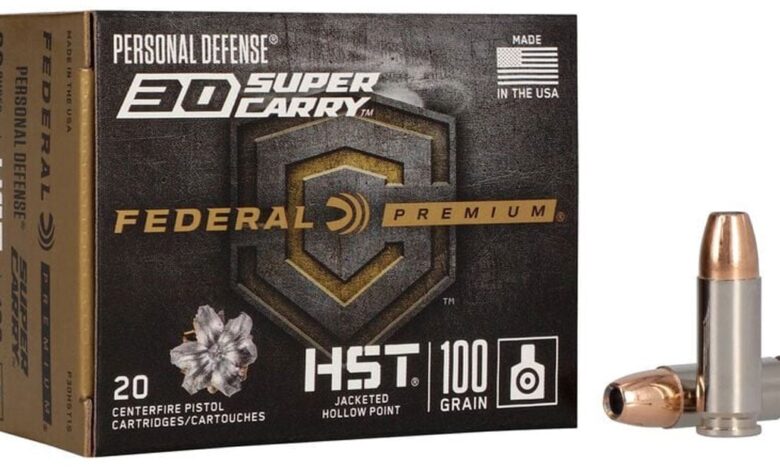The 30 Super Carry: Innovation or Insignificant?

Lots of things come and go in the gun world, cartridges among them. Two of the best-known examples are the .40 S&W and the .45 GAP. Both were hailed as innovative game changers when they first appeared, and both made a splash for a while, then dropped off most people’s list of favorite cartridges, no insult intended to anyone who likes them.
The .40 S&W was developed in 1990 after the infamous 1986 Miami-Dade Shootout when the FBI decided they wanted a more powerful handgun cartridge. They liked the 10mm, but it had more recoil than many of their agents could handle, so the .40 S&W was developed to fill the need. It became an immediate success with law enforcement. However, later analysis of police-related shootings involving mid-thoracic hits established that there was very little difference in the real-world performance of the 9mm, .40 S&W, .45 ACP, and even the 10mm. On top of that, 9mm cartridges were rapidly improving, and in 2015, an FBI study determined that modern 9mm rounds were effective enough that they transitioned back to 9mm. It’s been downhill for the .40 S&W ever since.
The .45 GAP (Glock Auto Pistol) was introduced in 2003 because many police departments using the Glock G21 .45 ACP said officers with smaller hands had difficulty holding its wide grip. The .45 GAP cartridge performed almost as well as the .45 ACP but was shorter, enabling it to fit in a handgun the size of 9mm. Again, the .45 GAP was initially a success. However, more ergonomic .45 ACP handguns and improvements in the performance of the 9mm cartridge combined to cut deeply into the .45 GAP market. Additionally, the ammunition shortage around 2012 made it easier to get 9mm and .45 ACP than .45 GAP. Most law enforcement agencies have switched back to 9mm, and although Glock still offers guns in .45 GAP, it is no longer a widely popular caliber.
Which brings us to the 30 Super Carry. Federal’s 30 Super Carry hit the ground running in 2022, receiving awards like Guns & Ammo magazine’s Ammo of the Year award and Ballistic Best magazine’s Best New Handgun Ammo award. But does it fulfill a genuine need in the defensive handgun world, or is it just another flash in the pan destined to ride high for a while and then crash into obscurity? More importantly, how viable is it as a self-defense cartridge for EDC?
The 30 Super Carry
Federal introduced the 30 Super Carry in 2022 specifically for the concealed carry market. Smith & Wesson collaborated with Federal to offer their Shield Plus and Shield EZ models in 30 Super Carry. The intent was to create a compact handgun for concealed carry that offered greater capacity than a 9mm but with better performance than a .380 ACP, and the 30 Super Carry accomplishes this. The Shield Plus in 30 Super Carry holds 16+1 rounds vs 13+1 for the same gun in 9mm, according to S&W’s product listing. The 30SC is also considered to have slightly milder recoil than a 9mm, although perceived recoil can be subjective. On the other hand, the bullet diameter is marginally smaller than either 9mm or .380, although not by much. I will go through the comparative ballistics a little later.
Is it a Genuine Innovation?
Federal has touted the 30 Super Carry as a major innovation and the biggest product they have ever launched. Federal’s Facebook page referred to it as the most revolutionary advancement in self-defense history. This is largely because, up until now, most cartridges used by the concealed carry community were originally developed a long time ago for military and law enforcement use. The .380 ACP was developed in 1908, the 9mm Luger in 1901, and the .45 ACP in 1904. Whether that qualifies the 30SC as the innovation Federal claims it to be is open to interpretation. Some people think so, while others have referred to it as the answer to a question nobody has asked.
What Federal did was to create a cartridge that is the same length as a 9mm; both are 1.169” overall but 1 mm smaller in diameter. A 9mm has a base diameter of 0.391″ while the 30 Super Carry has a base diameter of 0.345″. For comparison, a .380 case is 0.374”. That allows an increase in capacity for the same grip width. For people who are concerned about capacity, this is a good thing; however, when compared to truly innovative cartridges like the FN 5.7x28mm, it doesn’t seem all that revolutionary.
Comparing the 30 Super Carry to the 9mm and .380 ACP
The 380 ACP cartridge is generally considered the smallest centerfire caliber that is adequate for use as a self-defense round. Of course, 9mm has become the most common concealed carry cartridge in America, and if it is not the Gold Standard, it is at least the cartridge that most people consider their go-to for defensive carry. As with anything in life, there are both benefits and drawbacks to the 30 Super Carry.
Capacity
As I have already mentioned. 30 Super Carry’s main claim to fame is the additional capacity it offers over 9mm. In fact, Federal’s motto for the cartridge is ‘More is Better.’ That extra capacity usually amounts to two or three cartridges, but given the limited selection of firearms chambered in 30 Super Carry, it is currently a negligible advantage. That could change later if more manufacturers begin to offer handguns chambered in it.
Recoil
Perceived recoil is a subjective trait. For example, there is no question the .357 produces more recoil than a .38 Special, but when you are comparing cartridges as similar to the 30 Super Carry and 9mm, or even the .380, the differences can be more difficult to measure. Perceived recoil is also a function of the gun from which any given cartridge is being shot. A micro-compact 9mm will produce more recoil than shooting the same cartridge out of a full-size Beretta 92FS simply because of the relative weight and ergonomics of the two guns. In general, however, most people shooting a 9mm S&W Shield and a 30 Super Carry Shield feel there is slightly less recoil from the 30SC.
Performance
The acid test of any self-defense cartridge is its performance in a defensive situation. Ballistic tables are a poor substitute for the real world, but they are all we have to go on in controlled testing. Federal’s ballistics comparison using their HST cartridge indicates that 30 Super Carry outperforms .380 ACP, but that should come as no surprise to anyone. More significantly, 30 Super Carry is very close to the performance of 9mm, being a little slower but having a little more muzzle energy. On the other hand, the bullet has a slightly smaller diameter and less expansion than either the 9mm or .380, but deeper penetration than either. The ballistics may vary with different brands of ammunition, but overall, the performance of the 30 Super Carry is comparable to the 9mm and better than the .380. Of course, if you run 9mm +P the differences in ballistics will be more pronounced.
Availability
This is one area where the 30 Super Carry falls short. As of the time this article was written, the selection of handguns chambered in 30SC is very limited. Smith & Wesson offers their Shield Plus and Shield EZ, both micro-compacts, in 30 Super Carry. The Shield Plus has a capacity of either 13+1 or 16+1 rounds, and the EZ has a capacity of 10+1 in 30 Super Carry compared to 8+1 in 9mm. Avidity Arms offers their PD10 pistol in 30SC. The PD10 is listed as a midsize handgun with a capacity of 12+1, which incidentally is the same capacity as the Taurus G2c and G3c handguns in 9mm. At one point, Nighthawk Custom offered their GRP 1911 style pistol in 30 Super Carry, but their website currently only lists it as being available in 9mm and .45 ACP, so that may no longer be the case. Finally, for folks who want a PCC, Hi-Point offers their excellent carbine in 30 Super Carry. That is not a large selection, and if there are more guns available in 30SC that I have missed, please let us know.
The ammunition situation for 30SC has improved since it was released. Of course, Federal offers both FMJ and their highly regarded HST in 30SC. Remington and Speer also offer JHP, and both as well as Bazer offer FMJ. Prices for 30SC are generally higher than for 9mm, especially for range ammo.
Competition
The 30 Super Carry does not meet the requirements for competition in either IDPA or USPSA matches. This may not matter to many shooters, but tactical competition is an excellent way to train, so it is a drawback in that regard.
Pros:
- Slightly more capacity than a 9mm
- Slightly less perceived recoil than 9mm
- Performance is comparable to the 9mm and better than the .380 ACP
Cons:
- Slightly less power than a 9mm
- Not authorized to be used for USPCA and IDPA competition shooting
- Limited selection of firearms
- Limited ammunition options
- Ammunition is more expensive
The Bottom Line
In my opinion, the 30 Super Carry is a decent cartridge but nothing special. It offers a small benefit in a slightly greater magazine capacity for the same size gun vs 9mm. Perceived recoil is slightly less than the 9mm, as is ballistic performance and bullet expansion. Currently, handgun manufacturers have not embraced the 30 Super Carry, making the selection of handguns chambered for it meager. Since the 30 Super Carry cartridge is new and was not developed for military or law enforcement use, the selection of ammunition is limited, and the prices are higher than for 9mm, especially for inexpensive range ammo. The 30 Super Carry cartridge does not meet the requirements for either IDPA or USPSA competition shooting, and since practical competition shooting amounts to excellent training, this is a definite shortcoming.
If you are new to concealed carry and looking for your first gun, choosing 30 Super Carry will drastically limit your choices when you are looking for the gun that is your perfect fit. If you are an experienced shooter and decide to add a handgun chambered in 30 Super Carry to your collection, you will be adding a caliber that has a limited cost-benefit ratio. Finally, whether you are a new or an experienced shooter, 30 Super Carry ammunition is probably going to remain more expensive and less available than 9mm, which could impact the amount of range time you put in. Does the 30 Super Carry have a future? Only time will tell.
Read the full article here






